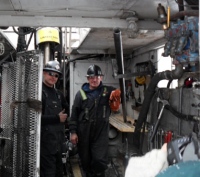Rio Tinto wins Hathor bid battle
01 December 2011
Rio Tinto has announced that its acquisition of Hathor for C$4.70 ($4.61) per common share has been successful after rival bidder Cameco allowed its offer for the Canadian uranium exploration company to expire.
 |
| Drill operators work summer and winter at Roughrider (Image: Hathor) |
According to Rio Tinto, all the conditions attached to its offer, made through an indirect wholly-owned Canadian subsidiary, have been met. The 94,950,089 Hathor common shares validly tendered by shareholders or held by an affiliate of Rio Tinto represent 70.21% of Hathor's outstanding common shares on a fully diluted basis. Rio has extended the deadline for its cash offer by ten days to give the remaining Hathor shareholders sufficient time to tender their shares before the new expiry deadline of 12 December.
Saskatchewan-based Cameco lodged an unsolicited bid of C$3.75 ($3.83) per Hathor share in August. Hathor's board urged its sharholders not to accept the offer, but was unanimous in recommending acceptance of a subsequent C$4.15 ($4.08) per share offer made by Rio Tinto in October valuing the company at some C$578 million ($569 million) on a fully-diluted basis. Cameco upped its offer to C$4.50 ($4.41) per share in mid-November; Rio Tinto countered by increasing its own offer to C$4.70. That proved to be a step too far for Cameco: the Saskatoon-based company announced on 28 November that it could not justify increasing the price beyond its current offer, due to expire the next day, and would accordingly allow it to lapse.
Hathor's Athabasca Basin exploration properties in northern Saskatchewan include its flagship Roughrider deposit, estimated to contain 17.2 million pounds U3O8 (6600 tU) in indicated resources and 40.7 million pounds U3O8 (15,650 tU) in inferred resources. Situated within 25 km of Cameco's existing Rabbit Lake uranium mill, any developer of the deposit would likely face the potentially expensive choice of building their own mill or using Cameco's facilities.
International mining group Rio Tinto is headquartered in London and operates the Rössing uranium mine in Namibia, in which it owns a 69% stake, and the Ranger mine in Australia through its 68% interest in Energy Resources of Australia (ERA). With annual uranium production of 6293 tU, Rio Tinto ranked fourth in the list of the world's top uranium producers in 2010. The company already has extensive non-uranium mining, manufacturing and exploration activities in Canada.
Cameco was the highest-producing uranium company in the world in 2010, with an output of 8758 tU from its operations in Canada, Kazakhstan and the USA. Cameco CEO Tim Gitzel said that his company's failure to secure Hathor would not adversely affect plans to double annual uranium output by 2018. "Our plan involves existing assets in our development pipeline and we remain on track to meet our objectives. We will continue to explore other growth opportunities, but only where there is a clear benefit to our shareholders," he said.
Researched and written
by World Nuclear News